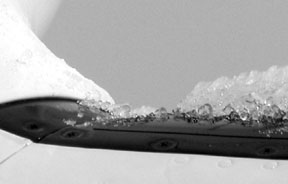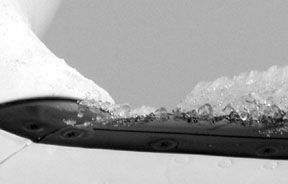
by Thomas P. Turner
As an instructor and aviation safety observer, I find that some pilots can be too cavalier about flight in potential icing conditions. And the accident record agrees. According to the 2003 Nall Report on general aviation mishaps, about 12% of the fatal reports included airframe ice as a factor. Thankfully, the outcome of an icing encounter is usually less dramatic. However, airplanes do get bent and broken in off-airport or hard landings after an icing encounter, and some pilots may need to change their shorts.
To be sure, ice is often fleeting and difficult to predict; by sticking to the letter of the law we end up canceling more flights than perhaps we need to. We never know what we many or may not have encountered; psychologically that doubt pushes us toward a go decision next time we face the choice. Or perhaps we pick up a little ice once or twice but everything works out … leading us to venture further into potential icing conditions on the next trip. The mishap record is peppered with reports of pilots who gave it a look and went too far. There is a process you can use, however, to determine the likelihood of ice accumulations and therefore make a good go/no-go decision.
But for this discussion, lets drop the whole question of whether its legal to fly in icing conditions. In FAR 91.9(a), the FAA requires flight within the published limitations of the aircraft, which will either state this airplane is certified for flight in icing conditions or flight into known icing conditions is prohibited. The FAAs enforcement actions and civil case law have repeatedly ruled that a forecast of ice constitutes a known icing condition. So you know in your heart that if the airplane isnt certified for known ice, it is illegal (not to mention dangerous) to be aloft in clouds or precipitation when there are forecasts or PIREPs of ice.
Instead, lets look at what you can do to determine where the ice is even before you leave the ground and maximize ice-avoidance safety once you as pilot-in-command have determined the safety and legality of the flight.
Beyond Temperatures Aloft
We all know that for airframe ice to form two conditions must exist: the airplane must be in visible moisture (clouds, precipitation or fog) and the temperature must be at or below freezing. Generally were taught to look at the Temperatures Aloft predictions and to stay away from freezing temperatures. Theres a lot more to ice forecasting than simply temperatures aloft, however, and a number of tools you can use to predict ice formation-so you can plan to avoid it.
When cold air aloft warns of possible flight icing, a more thorough check of weather information can help you pick an altitude and route for ice avoidance. See below for examples of these graphic weather products.
Surface analysis: Most airframe icing occurs near frontal zones, so a first look at large-scale weather patterns tells you where the fronts are. Look also for wind flow across large bodies of water, like the Great Lakes-icing is very common downwind of water, especially where those winds are lifted by frontal activity or terrain.
Pilot reports: Pilot reports are like news flashes of conditions where forecasters otherwise cannot see. Ice accumulation and the height of cloud tops are two vital pieces of planning information available only by reporters on the scene. But consider the source: icing PIREPs may tend to be overblown by pilots of training-type airplanes like Cessna 172s and Piper Cherokees, and underestimated by the macho pilots of freight haulers, turboprops and jets. What may be an accurately reported trace of ice in climb by a 737 will likely be far heavier on your piston airplane, which will spend more time passing through freezing clouds. Any pilot report of airframe ice means you need to put considerable thought into your avoidance and escape strategy.
Satellite Imagery: Satellite maps tell at a glance whether clouds have formed, a vital component to your preflight ice strategy. Check the pictures effective time-the satellite picture is a snapshot of the clouds in place at the time the picture was taken, not a depiction of current conditions and certainly not a prediction for the future except to illustrate large-scale trends. Images taken at night use infrared, not visible, imagery, and do a less effective job of showing some types of clouds.
Constant pressure chart: The constant pressure chart is the only forecast tool that predicts whether clouds will exist at altitude. Forecasts exist for these altitudes:
1000 millibar level, approximately at the surface
850 millibar, around 5000 feet MSL
700 millibar, approximately 10,000 MSL
500 millibar, around 18,000 MSL
300 millibar, 30,000 MSL
200 millibar, 39,000 MSL
Important for our purposes, each chart depicts areas where the temperature/dew point spread is less than 3˚ C in green shading or, in some sources, by a completely filled circle in the station model for underlying reporting points. A close temperature/dew point spread means cloudiness-and if temperatures permit, ice-is likely.
Current icing potential and Forecast icing potential: Available at adds.aviationweather.gov/icing/, these recent products take into account all manner of ice-producing factors, including temperature, dew point, and water droplet size to produce statements of the likelihood of ice at the time of observation and in the future. You can view altitudes in 3000-foot increments from the surface to 18,000 feet and find the probability of ice formation. Any ice-related PIREP information is also plotted on the CIP. Note that the CIP and FIP make no statement about the type or intensity of ice formation-simply whether any ice is likely.
The Numbers Game
To put some of this in perspective, CFII and meteorology researcher Scott Dennstaedt provides a unique aviation weather seminar called Ice is Not Nice. In his seminar-learn more about it at www.chesavtraining.com-Dennstaedt outlines the results of his research into airframe icing. He notes that, even in freezing temperatures, if the temperature/dew point spread is greater than 3˚C, there is an 84% probability there will be no airframe ice. If the spread is 3˚C or less the tables turn and theres an 80% probability there will be airframe ice if the ambient temperature falls into the freezing range.
Theres no accurate way to predict, however, the extent or intensity of ice that may form. Although PIREP reporting is underutilized and therefore does not paint a complete picture of the sky aloft, Scott uses PIREPs to try to address intensity forecasting. From his research he claims that warm air advection (air being lifted in an unstable or orographically lifted warm front) that there is a zero percent probability of moderate or greater ice accumulation. In cold front advection, on the other hand, a temperature/dew point spread less than or equal to 3˚ C results in a 100% probability of moderate or greater icing at freezing altitudes. Continuing his PIREP-based research, Scott concludes that steady precipitation at the surface corresponds to an 80% chance of trace icing and 20% of light or greater icing in the clouds above, while lack of surface precipitation reverses the chances, an 80% probability of light or greater icing and a 20% chance any ice will be merely of trace intensity.
Further, still from Scotts study:
Reports of rime ice account for 72% of all icing PIREPs;
Clear ice is reported in 20% of reported ice encounters; and
Eight percent of icing PIREPs report mixed ice 8%.
85% of all structural icing PIREPs occur in frontal zones.
Known Ice
Anyone who feels even a known ice piston airplane can handle continuous ice ought to read the fifth chapter of Ernest K. Ganns Fate is the Hunter, where the crew of a deiced Douglas airliner narrowly averts ice-laden stalls and what we now call Controlled Flight Into Terrain under a load of ice over the Tennessee mountains. Even the U.S. Air Forces 1951 instrument flying techniques manual, from the era when almost all Air Force airplanes had ice protection devices very similar to what known ice piston airplanes have today, states that de-icing equipment should be used to enable the aircraft to reach ice-free levels safely, not to maintain flight in icing conditions. By definition moderate ice accumulation requires continuous use of deice equipment-continuously popping the boots on pneumatically deiced airplanes. Thats a lot of ice. Even then, according to definition, flight for more than an hour in icing conditions is considered hazardous as ice builds on unprotected surfaces. Ice crystals themselves make one of the best condensation nuclei for additional ice build-up … the rate of ice accumulation can grow exponentially once it begins to adhere to the airframe.
Approaches And Drift-down
Pilots of big-engine airplanes, and especially promoters of aftermarket turbocharger and turboprop modifications to piston-engine aircraft, almost always highlight the ability to climb rapidly through ice as one of the benefits of additional power. Certainly a higher climb rate results in less time spent at any given icing altitude, reducing ice-related risk. Trouble is, eventually you have to come back down into it. Virtually all airframe ice-related accidents (and remember, these are almost universally fatal) happen during the approach and landing phase of flight. Extra engine power is of little help when time comes to slow the airplane for landing.
Consider carefully, then, whether the ability to climb rapidly through ice is always a good thing. Assuredly it is helpful as part of an escape mechanism if you encounter unexpected ice en route. And if potential icing conditions are very localized, meaning you will soon fly to an area with no risk of ice below your altitude, popping up through an ice layer to ice-free air above presents a reduced risk so long as youll not have to drop back into icing at destination.
The unexpected descent, for mechanical or weather-related reasons, also frequently appears in NTSB reports. In cases of icing its usually a heavier-than-expected accumulation that forces diverting to a nearby alternate. Sometimes its the failure of equipment (usually engines or electrical systems) that dictate an unexpected descent. Woe to the occupants of the airplane that is forced to descend into ice with degraded or no ice protection capability. Its like a VFR-only pilot who climbs through a hole in the overcast, hoping another hole will appear at his destination–although climbing to escape an icing encounter is often a good short-term tactic, the better long-term strategy is to try to prevent flight with a layer of ice between you and the ground. Will this decrease the utility of your airplane in the wintertime? Yes. Is flying for long periods above an icing layer, even in an ice-certified airplane, an unacceptable risk? Thats for you as pilot-in-command to decide.
Chesapeake Aviations Scott Dennstaedt puts it best when he says you should treat icing like you would smoke in the cockpit-take action immediately at the very first sign of ice accumulation. Changing altitudes to one known to be outside the freezing temperature range and/or out of visible moisture is usually the quickest way to exit icing conditions. Best results come from planning to avoid potential icing conditions altogether.
Also With This Article
“Where The Ice Is”
“Preflight Ice Avoidance Tools”
“Ice Penetration Speed?”
“Ice Avoidance Checklist”
-Tom Turner is a CFII-MEI who frequently writes and lectures on aviation safety.




